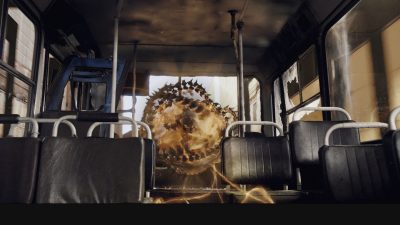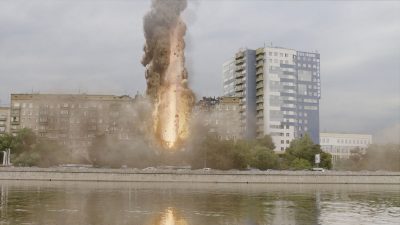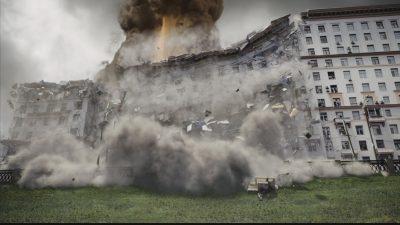In Chris Gorak’s The Darkest Hour, a group of friends band together against an alien invasion that threatens Moscow through the city’s power supply. Overall visual effects supervisor Stefen Fangmeier tapped Buf to realize various aliens and parts of the destruction they wreak on the Russian capital. Pierre Buffin led the artistic direction of Buf’s work, with Stéphane Nazé as Buf’s VFX supe and Thomas Schober as VFX producer. Buffin tells fxguide about the design behind some of the specific sequences in the stereo film.
fxg: Can you talk about the tools and techniques you were using to construct the alien, in terms of the creature inside, the shield, the ‘transparency’ look and the fire and tendril effects?
Buffin: Important research work was completed by the designers to precisely define the shape and the appearance the aliens and their tendrils should have. Then, we completed 3D research on the manner they should move, their shields and the electrical effects. Many algorithms were developed for this part. As some vendors shared a certain number of similar effects, the challenge was to share the algorithms in order to achieve the same result.
 fxg: For the tram scene, how did they film the plates?
fxg: For the tram scene, how did they film the plates?
Buffin: The tram sequence was filmed on stage, while the background and the tramway animation was handled in post-production – the set being recreated using 3D photogrammetry. So, matching the speed and the set locations was directly managed in the final edit.
fxg: What kind of particle and smoke effects and other techniques were used to make the alien towers?
Buffin: The alien towers requested a lot of research, and their design evolved during the post-production. Originally, the towers were constructions. They evolved into far more organic forms as their purpose was to show how the aliens foraged raw materials from the Earth. The towers consist of a energy core within which the gathered material is sent into space. The action of these energy cores produce huge columns of smoke. We were inspired by the columns of smoke from volcanic explosions.
 fxg: For the collapse of the building, what approach did you take to simulating the breaking glass and materials?
fxg: For the collapse of the building, what approach did you take to simulating the breaking glass and materials?
Buffin: While the building collapse is handled in 3D simulation, Chris Gorak and Stefen Fangmeier wanted to be able to decide – depending on the edit – the speed and the manner the building would collapse. The building was entirely built in 3D then collapsed to enable us to adjust the simulations involving millions of pieces of glass and concrete.
fxg: Can you talk about how the shot of the actors jumping into the water was designed, shot and then finally completed?
Buffin: The boat, the set and the submarine shot are three different locations. The submarine shot was filmed underwater in a pool and without a 3D rig. We dimensionalized the shot in 3D while adding debris and images of Moscow through the water surface.
 fxg: What kind of tools did BUF use to view and make stereo adjustments for the film?
fxg: What kind of tools did BUF use to view and make stereo adjustments for the film?
Buffin: Some shots were color-corrected at B-Mac (BUF Laboratory) on Baselight. Other shots were directly handled by BUF teams, our tools being adapted to 3D stereoscopy: our viewer is in stereo, the rendering is completed for both eyes at the same time and our compositing tool also manages the two streams.
All images and clips copyright © 2011 Summit Entertainment. Courtesy of Buf.
